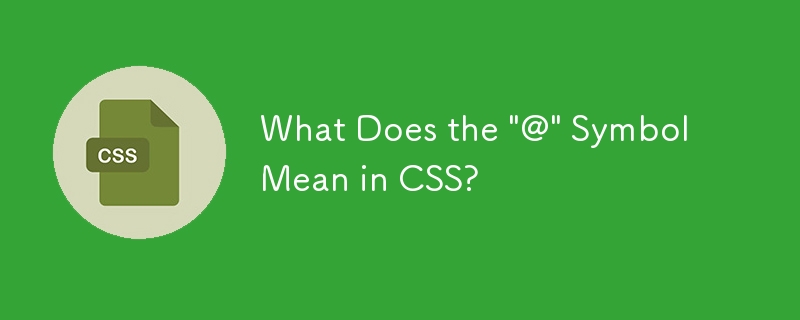What Does the \'@\' Symbol Mean in CSS?

Understanding the '@' Symbol in CSS
In the enigmatic world of CSS, one encounters intriguing notations that often spark questions. Among them is the mysterious '@' symbol, which has captured the attention of many puzzled users.
To answer the burning question: the '@' symbol is an integral part of CSS's at-rules, special instructions for the browser that play crucial roles in controlling how styles are applied.
What are At-Rules?
At-rules begin with the '@' symbol, setting them apart from regular CSS rules and properties used for styling elements. These special instructions provide additional functionality beyond the standard styling capabilities, influencing how styles are applied and executed.
Examples of common at-rules include:
- @import: Imports styles from an external stylesheet.
- @media: Controls which styles apply based on media characteristics (e.g., print, mobile).
- @font-face: Defines custom fonts for use in website designs.
Role and Impact of At-Rules
- @font-face: Enables you to embed custom fonts into your website, ensuring they are rendered uniformly across browsers, even on computers that do not have the fonts installed.
- @media: Allows for dynamic styling, adapting the website's appearance based on the viewing environment (e.g., device, print). By controlling which styles apply in specific media contexts, you can optimize the user experience.
Other Notable At-Rules
Beyond the commonly known at-rules, CSS encompasses a vast array of additional rules with specialized functionalities. These include:
- Conditional rules
- Keyframe animations
- Paged media
It's important to note that at-rules are not related to selectors and are defined in different ways across various CSS modules, reflecting their diverse nature.
The above is the detailed content of What Does the \'@\' Symbol Mean in CSS?. For more information, please follow other related articles on the PHP Chinese website!

Hot AI Tools

Undresser.AI Undress
AI-powered app for creating realistic nude photos

AI Clothes Remover
Online AI tool for removing clothes from photos.

Undress AI Tool
Undress images for free

Clothoff.io
AI clothes remover

Video Face Swap
Swap faces in any video effortlessly with our completely free AI face swap tool!

Hot Article

Hot Tools

Notepad++7.3.1
Easy-to-use and free code editor

SublimeText3 Chinese version
Chinese version, very easy to use

Zend Studio 13.0.1
Powerful PHP integrated development environment

Dreamweaver CS6
Visual web development tools

SublimeText3 Mac version
God-level code editing software (SublimeText3)

Hot Topics
 1664
1664
 14
14
 1421
1421
 52
52
 1315
1315
 25
25
 1266
1266
 29
29
 1239
1239
 24
24
 Google Fonts Variable Fonts
Apr 09, 2025 am 10:42 AM
Google Fonts Variable Fonts
Apr 09, 2025 am 10:42 AM
I see Google Fonts rolled out a new design (Tweet). Compared to the last big redesign, this feels much more iterative. I can barely tell the difference
 How to Create an Animated Countdown Timer With HTML, CSS and JavaScript
Apr 11, 2025 am 11:29 AM
How to Create an Animated Countdown Timer With HTML, CSS and JavaScript
Apr 11, 2025 am 11:29 AM
Have you ever needed a countdown timer on a project? For something like that, it might be natural to reach for a plugin, but it’s actually a lot more
 HTML Data Attributes Guide
Apr 11, 2025 am 11:50 AM
HTML Data Attributes Guide
Apr 11, 2025 am 11:50 AM
Everything you ever wanted to know about data attributes in HTML, CSS, and JavaScript.
 A Proof of Concept for Making Sass Faster
Apr 16, 2025 am 10:38 AM
A Proof of Concept for Making Sass Faster
Apr 16, 2025 am 10:38 AM
At the start of a new project, Sass compilation happens in the blink of an eye. This feels great, especially when it’s paired with Browsersync, which reloads
 How We Created a Static Site That Generates Tartan Patterns in SVG
Apr 09, 2025 am 11:29 AM
How We Created a Static Site That Generates Tartan Patterns in SVG
Apr 09, 2025 am 11:29 AM
Tartan is a patterned cloth that’s typically associated with Scotland, particularly their fashionable kilts. On tartanify.com, we gathered over 5,000 tartan
 How to Build Vue Components in a WordPress Theme
Apr 11, 2025 am 11:03 AM
How to Build Vue Components in a WordPress Theme
Apr 11, 2025 am 11:03 AM
The inline-template directive allows us to build rich Vue components as a progressive enhancement over existing WordPress markup.
 PHP is A-OK for Templating
Apr 11, 2025 am 11:04 AM
PHP is A-OK for Templating
Apr 11, 2025 am 11:04 AM
PHP templating often gets a bad rap for facilitating subpar code — but that doesn't have to be the case. Let’s look at how PHP projects can enforce a basic
 A Comparison of Static Form Providers
Apr 16, 2025 am 11:20 AM
A Comparison of Static Form Providers
Apr 16, 2025 am 11:20 AM
Let’s attempt to coin a term here: "Static Form Provider." You bring your HTML




